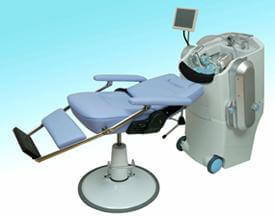
I remember back in the 1980s, water was like a scifi robot’s kryptonite. Now, if you splash a bot it’ll probably just assume you want it to give you a shampoo. At the recent International Home Care and Rehabilitation Exhibition 2010 (HCR 2010), Panasonic unveiled two new technologies to help healthcare workers tending the sick and elderly. The first was a robot washstand that will automatically clean a patient’s hair from start to finish. The device uses sixteen ‘fingers’ to gently massage the scalp. It has a 3D scanner so that it can use the correct pressure and comes with memory so that it can recall the preferences of each individual. Panasonic also demonstrated their new Roboticbed, which is actually both a bed and wheelchair. The device transforms from one shape to the other, minimizing the risk that a patient will fall or be dropped moving from bed to chair. Both devices are aimed at giving healthcare workers more free time to focus on health rather than mundane tasks. Watch the Panasonic presentations at HCR 2010 in the videos below. The shampooing robot looks pretty amazing – I wonder if it’s taking appointments?
Another video showing a close up of the shampooing process:
We’ve already seen various robotic lifting devices from Panasonic aimed at medical applications, including a wheelchair-bed transformer. This new version’s pneumatic manual controls are a good addition, giving healthcare workers more flexibility in how the platform can be used. It’s hard to hear in the following video, but the bed also makes an audible announcement (using a simulated voice) as well as flashing LED lights when the wheelchair is fully docked back into the bed station.
The world population is getting older, and an increasing share of our economy will need to be focused on tending to elderly populations in the decades ahead. Japan is particularly concerned with this trend, and unsurprisingly has focused on robotics as the solution. I’m curious, however, as to how well these systems will be accepted by the elder population at large. Will they simply be yet another series of mechanisms, like motorized wheelchairs and automatic doors, that are adopted easily? Or will the increased capabilities of robots require patient’s to make a leap of faith? Beds that transform into wheelchairs are actually fairly mundane, even if they are motorized. Putting your head in a sink and having your hair washed by a machine – that’s different enough to give someone pause. And it’s probably only a matter of time before a more elaborate system could be built to provide a full shower. Robotic Elder Care Washers …try not to remind Grandma that you use a similar machine to clean the family car.
[image credit: Panasonic]
[source: Panasonic Press Release]



